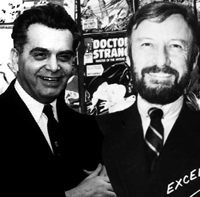The Truth About Stan Lee
The Truth About Stan Lee
Stan Lee passed away the other day. With his passing came an avalanche of news reports and tributes to his career that ranged from mostly inaccurate to wholly inaccurate.Anyone who knows me will tell you that I have always been staunchly on team Kirby/Ditko when it comes to who created the Marvel Universe. But if you ask me who should get the credit for the success of Marvel Comics, the answer is Stan Lee.
If you put aside his hucksterism, his shameless self-promotion and his dubious depiction of his role in the creation of these immortal characters, Stan Lee was one hell of an editor. He was the best comics editor ever to wield a blue pencil.
He may not have played the role attributed to him (mostly thanks to him) by mainstream media in the genesis of these characters but he sure knew what to do with them. One of the famous nails in the coffin of Jack Kirby's 60s tenure at Marvel was Stan Lee's appropriation of a character Jack had casually tossed into the epic Galactus trilogy in The Fantastic Four. In Jack's mind, the Silver Surfer was merely a drone, a soulless tool whose only purpose was to find planets for his master to consume.
Lee gave him a name, Norrin Radd, and developed him into a character of Shakespearean pathos, who sacrificed his humanity to save his homeworld and his beloved Shalla Bal. Stan's initial run on The Silver Surfer solo comic may not have been commercially successful but it was intellectually ambitious and the first indication of what the medium could become in a literary sense.
As an editor, Stan established the overarching moral philosophy of Marvel. He reined in Kirby's often out of control imagination which, admittedly, sometimes got in the way of coherent storytelling.
But Stan wasn't just a strong editor when it came to writing and the editorial direction of a comic, he was the de facto art director. Stan held the books under his purview to a very high standard visually. Just peruse the many dozens of issues of The Jack Kirby Collector to see countless examples of covers and page sequences that were rejected by Stan because of awkward perspective, lack of energy or confusing panel sequences.
Stan Lee is portrayed by his detractors as some kind of self-aggrandizing pimp who took money on the lecture circuit on the backs of the work of others and, to some extent, he was. After he handed the editorial reins of Marvel to "Rascally" Roy Thomas in the early 70s, he devoted most of his time to promoting Marvel Comics and himself.
But in the 60s he was George Martin, making sense of all the creative chaos being thrown his way by two visionary artists. He was hands on and he knew what he was doing. Sadly, Stan Lee's true and essential role in the story of Marvel often gets lost in the argument.
Eric Sandberg




Well done.
ReplyDelete